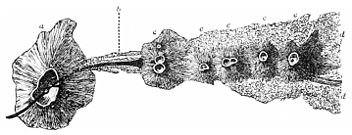cones have been formed around the main cone. Another example is furnished on the slopes of Etna, where the scoria-cones raised in 1865 along a fissure were so close together as to make a long, irregular ridge (Fig. 10). Seven of these cones were formed along this fissure,

thirty-six along another fissure during the eruption of 1874. Similar phenomena were witnessed upon the slopes of Vesuvius in 1760, when a fissure opened on the south side of the mountain, and fifteen scoria-cones, which are still visible, were thrown up along it.
The center of eruption has sometimes shifted itself along a line of fissure, as has taken place at Etna, where the present center is four miles from the old one, and in the Island of Vulcano with the peninsula of Vulcanello, which affords the best possible example of such a shifting. Whole systems of volcanoes appear to be built up along the lines of such fissures, as is shown by the linear arrangement of volcanoes in different parts of the earth, and strikingly in the Lipari Islands, where the volcanoes are arranged along a series of lines which doubtless mark rents in the earth's crust, and which radiate from a center at which we have proofs of the former existence of a volcano of enormous dimensions.
There is also good ground for believing that the great linear bands of volcanoes which, as we shall see, stretch for thousands of miles over the earth, have had their positions determined by great lines of fissure in the earth's crust. While, however, the smaller fissures, upon which rows of scoria-cones are thrown up, seem to have been in many cases opened by a single effort of the volcanic forces, the enormous fissures which traverse so large a portion of the surface of the globe are doubtless the result of numerous manifestations of energy extending over vast periods of time.
It is very hard accurately to estimate the number of volcanoes in the world. They vary in size from immense mountains like Chimborazo and Cotopaxi to mere holes in the ground, letting escape barely perceptible columns of vapor. The history of a large proportion of them has been known only for a brief period, and many which are considered extinct because they have never been seen in action may be merely dormant, ready to burst out at any time, as Vesuvius did in
